Online adspend growth halved in 2008
Posted in: UncategorizedLONDON – Growth in UK internet advertising has slowed considerably in the first half of 2008, returning a 21% year-on-year increase – just over half the rate post-ed in 2007.
LONDON – Growth in UK internet advertising has slowed considerably in the first half of 2008, returning a 21% year-on-year increase – just over half the rate post-ed in 2007.
LONDON – In response to cash-strapped consumers cutting back on discretionary purchases such as magazines, publishers are starting to promote cut-price annual subscriptions.
LONDON – Online social networking is a powerful form of consumer engagement for marketers, but they need to interact with consumers without letting the brand take over, speakers at the AOP digital publishing summit highlighted.
LONDON – Recruitment is still the biggest sector category spending online with a 32.9% share of online revenues for the first half of 2008, according to new figures from the Internet Advertising Bureau and PricewaterhouseCoopers.
LONDON – With the financial landscape changing almost by the day, Media Week took a look at the billings of some of the high street’s best-known institutions.
LONDON – Just a year ago, investors were queuing up to buy media companies. Fuelled by access to cheap debt, the likes of Quadrangle and Cinven were reportedly vying with £1bn-plus offers to buy Emap’s consumer magazines arm.
LONDON – Cut costs or invest in your products and services? Media Week asked industry leaders for their tips to avoid the worst of the financial fallout.
LONDON – Media Week asked the big players in the industry – clients, media owners and agencies, from Martin Sorrell and Steve King to John Cresswell and Brendan Condon – to tell us how the financial crisis has impacted their business.
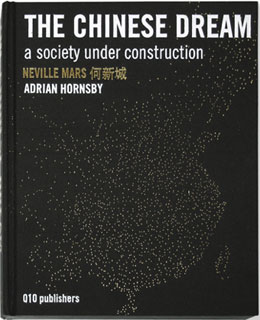 The Chinese Dream – A society under construction, by DCF, Neville Mars and Adrian Hornsby.
The Chinese Dream – A society under construction, by DCF, Neville Mars and Adrian Hornsby.
Publisher 010 says: What if you built the whole mass of western europe in 20 years? What if 400 million farmers then moved in? What would it look like? How would it work? Would you be able to go to sleep at night? And if you did, would you dream of somewhere else …?
China is in the midst of breakneck transformation. The last 30 years of astonishing economic growth and political and cultural reform have been driven by the world’s biggest ever urban boom. The new China is now halfway built. Within the next 30 years China will most likely take centre-stage as a global superpower, with hundreds of millions of new urbanites flooding into the rapidly swelling cities. But this process – presenting no less than the construction of a new society – is taking place almost without time to think.
Taking as its starting point the goal announced in China in 2001 to build 400 new cities of 1 million inhabitants each by 2020, or 20 new cities a year for 20 years, the book explores the hopes and hazards of dreaming on such a scale. The question being asked is in fact no less than how to build a new utopia. But is China mortgaging its present for a promised future, and doing so at the same time that current speeds of construction eclipse any real forward planning?
Partly because of the Olympics, publishing houses have been releasing books about China by the dozens, with massive and super fast urbanization appearing to be the most popular subject by far. And who could blame the public for being so fascinated by back covers that repeat again and again figures and facts such as:
‘China is the fourth largest economy in the world. If current growth rate continue, China will outsize the U.S. in the next 20 to 30 years’
‘By 2020 China’s national network of expressways will exceed in length even the American interstate highway system.’
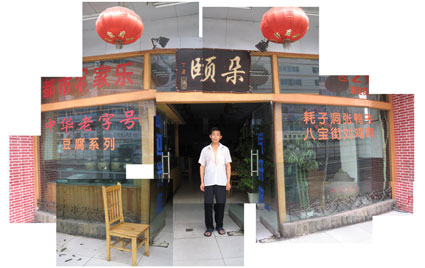
Photo-collage by Martijn De Waal. Bigger version online and inside the book
Some of these publications are genuinely well-researched and carefully written, others feel more like a quick and opportunist job. If you have to get your hand on just one book about urban China, make it this one. It is the result of several years of works by experts who were called to reflect on possible scenarios for urbanization in China in 2020. It is also great ‘value for money’, not just because the price is surprisingly affordable for a book that counts 700 pages but because once you open it you realize that it’s almost a work of art. The typo, graphic design, the photos, the layout, the graphics, every page has been meticulously crafted. And i have photos to prove my claim:
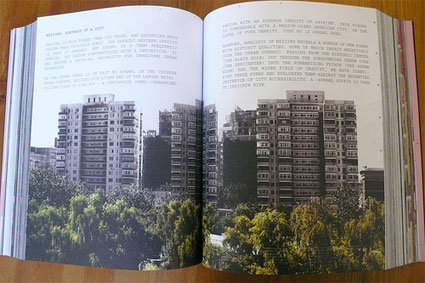
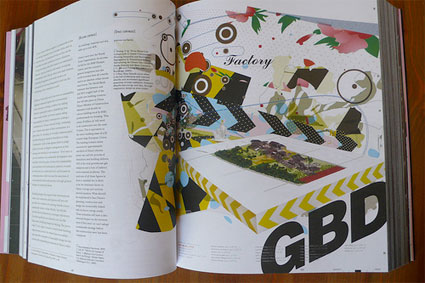
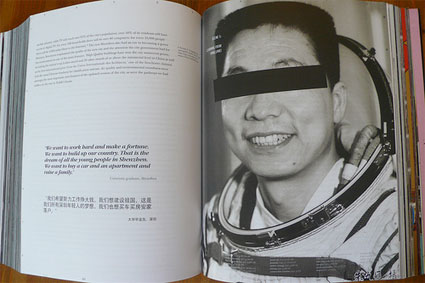
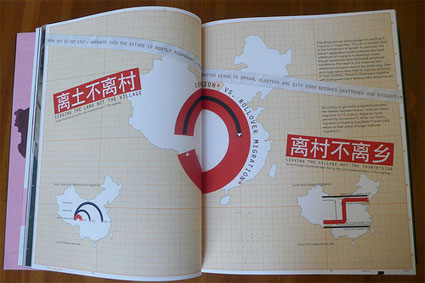
The urban (near) future of China is analyzed under every angle: economics, society, ecology, energy, architecture, urban planning and politics.
Some books about similar subject shun from any mention of China’s political situation. This one doesn’t. It’s not exactly heavy on politics but its authors recognize that, while ‘it’s urbanization not democracy that constitutes the main driver for change in China’, it would be naive to try and draw a clear picture of Chinese cities without taking the CCP (Chinese Communist Party) factor into account.
More importantly, the books holds a mirror to our ‘Western societies”. We’ve arrived at a crossroad where we are forced to stop and look with horror at the shortcomings of the capitalist model, a model that China is embracing fast, steady and avidly. The more i read about China’s frenzy and excesses the more i was remembered of ours. Of course there are many differences: we know of the ‘American dream’ but how much exactly do we know of the ‘Chinese dream’? We might have often read that one of the main goals of China is to create a broad middle class which will, of course, form the least saturated market we can dream of, but are we sure that the Chinese will blindly follow our ‘credit-addiction’ and other eco-suicidal habits?
I almost forgot to mention my favourite part of the book: the ‘Glossary / From Lipstick to Skyscraper’. Some of the words and expressions relate to urbanization all over the world (archi-scrabble, anyone?). Some are peculiar to China: Chinese immobility, Chinese Moderni$m, Chengdu 1.5, dormitory extrusion, floating village, panda-hugger, Shanghai fever, chiburb, etc.
If 700 pages are not enough, head to BURB.TV, the collaborative research wiki that updates and expands into the larger knowledge of The Chinese Dream. Each article is a topical blog or BURB into which texts, images, and discussion are submitted. The research is produced with visionaries, architects, planners and social scientists invited by the Dynamic City Foundation.
Related: Book Review – The Concrete Dragon: China’s Urban Revolution and What It Means for the World.
Global Cities at Tate Modern.
The Chinese Far West, Get It Louder (Part 1, China), China China China China !!! Chinese contemporary art beyond the global market, Neural magazine special China, China Now at the Cobra Museum, Beijing’s “hutong” destruction, 798 art district in Beijing + The 798 art district, take two.
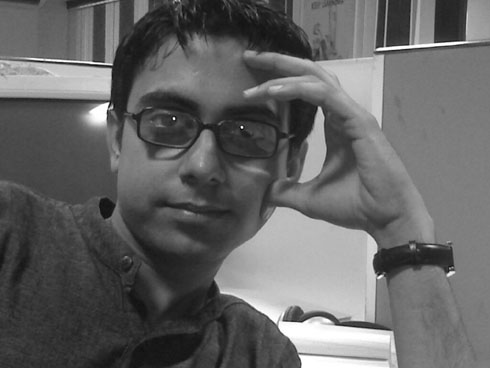
Well, I belong to a family of artists. Dad was an actor; a stage actor, he is still a poet and a photographer. As for mom, she was a poet too. As for my brothers Shandar and Tajdar, one is an animator, and the other one is a musician respectively, that too one of the top five guitarists in India… So I guess I didn’t have to go out to get inspired…but yes teachers in school really influenced me a lot. They always pushed me into art…I went to a school called St.James School in Calcutta, which was not an art school, sadly.I started working when I was in class nine, got into a much reputed advertising studio, “WYSIWYG” What You Seek Is What You Get” in Calcutta. Worked after school hours, While doing illustrations on paper there, I realized that animation was something I wanted to do . Moved up to Bombay…worked around in some major studios…Animation Dimension, Hungama, Webchutney and the journey is still on….

